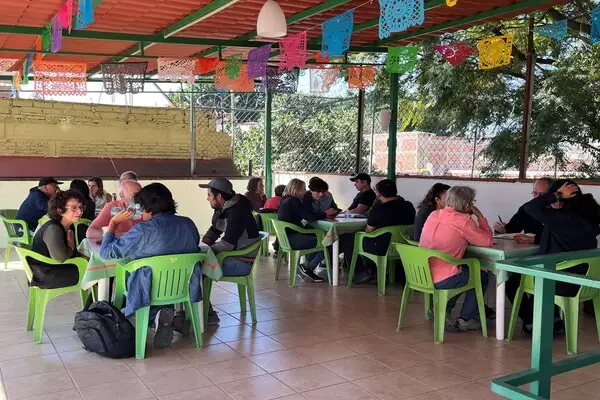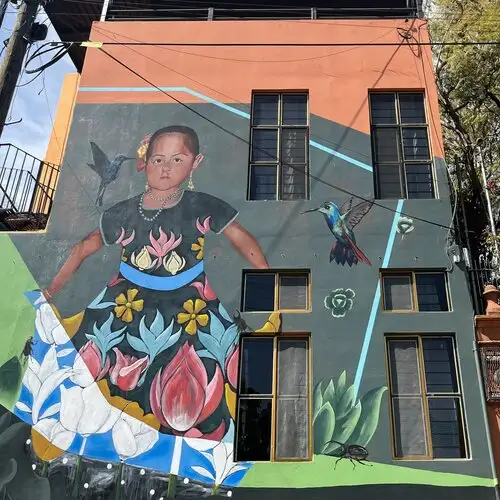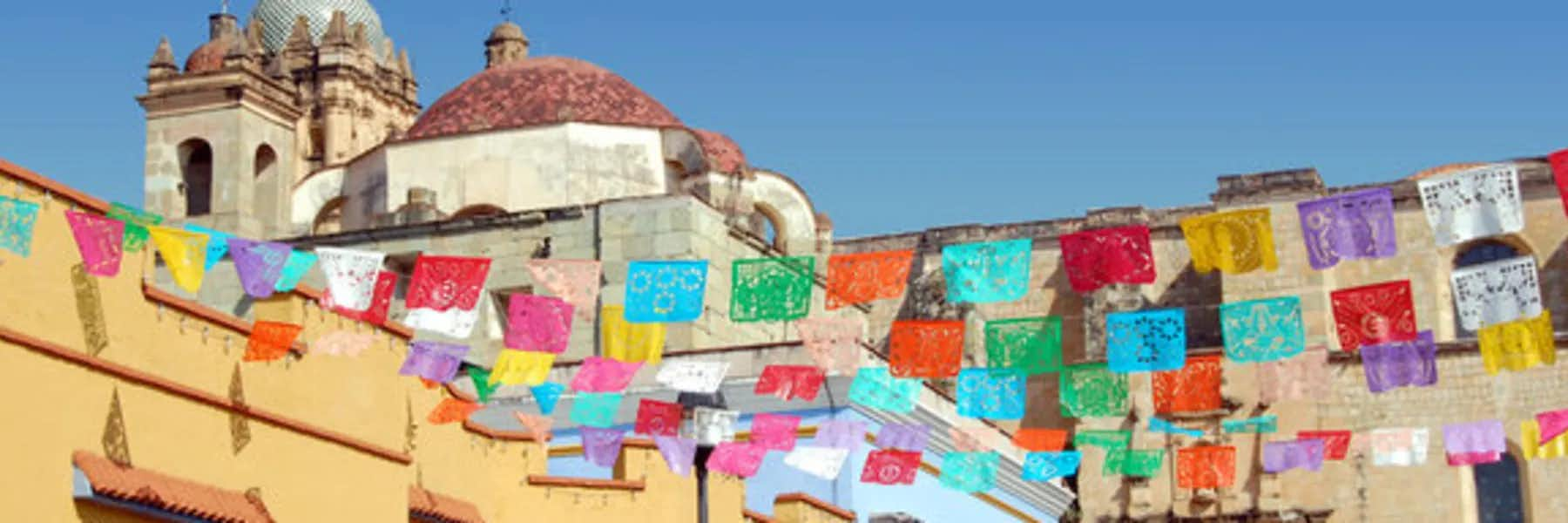We are taking a four-month scouting trip to find our perfect part-time home. After a three-month motorcycle trip through Mexico in 2022, hitting some 30+ towns, we decided Oaxaca and Puerto Escondido were worth a deeper dive. So, we have spent January and February here in Mexico, and in April, we will head across the Atlantic to check out Spain and Portugal for the same purpose.
We aim to gather enough information from all four places to make an educated and realistic decision about where to spend at least half the year. We purposely picked very different cultures and geographies, so there’s a broad comparison choice. While we own a home in Colorado and Key West, the idea is to keep those rented and be abroad from January through June. Mexico makes sense in the heart of the winter for its warm weather, then enjoy springtime in Spain or Portugal. Sounds like a good plan, right?
Why Oaxaca?

There are a few good reasons for considering Oaxaca (pronounced “wa-hock-a”) for a relocation.
Oaxaca (the city), located in the state of Oaxaca, is about a five-hour car ride south of Mexico City. Direct flight connections are good from multiple U.S. cities or connecting through Mexico City or Guadalajara. We flew in from Denver with just one stop in Dallas.
Hands down, the winter weather is divine. We are accustomed to the humidity of Key West, but at 5,000 feet elevation, the dry climate of Oaxaca is a welcomed change. Combine that with low 80s during the day and 60s at night, and you have a new perfect situation.
The state of Oaxaca is the fifth largest in Mexico, so you get a little bit of everything; mountains, the Pacific Ocean, beaches, forests, and rivers. What’s also cool is the cultural diversity because of some 20 indigenous groups that reside within the state. With ancient rituals, handcrafted textile expertise, and their own language, visiting these tribal people in outer-lying areas makes for fascinating day trips.
Getting Oriented
We hit the ground running by making the Oaxaca Lending Library our first stop. Yes, it’s a library but more importantly, it’s a social networking hub for expats. Monday mornings are a scheduled welcome event for newcomers to the city. Find out what color taxis to avoid and where to go for the best haircut. It’s that kind of practical information.
The library operates Oaxaca Events, a goldmine for knowing what’s happening in town. Whether it’s evening music, daytime hikes, gallery showings, sporting events, poetry readings, or yoga classes, it’s all listed here. Que Pasa Oaxaca is also a valuable site for social events.

Improving our Spanish was a priority, so we took full advantage of the free Saturday morning Inter Cambio at the library. It’s a two-hour language exchange where two non-native Spanish speakers are paired with two Spanish speakers. Not only did this help with our language skills, but it proved to be a great way to meet people. This is where we met a young man who works as an interpreter, whom we ultimately hired for private lessons. And while it is predominately retired-age foreigners, the Mexican students vary in age, giving a broader perspective of what local life is like in Oaxaca.
Finding Housing in Oaxaca
Like many towns worldwide, the influx of snowbirds, expats, and digital nomads has put a squeeze on housing. Since we anticipate returning for several months next year, we looked at some Air B&Bs here. Because it is high season, many units were occupied, but some owners let us in on cleaning day or in between rentals.
While we stayed in the Centro area this time, we’d like to try a more residential neighborhood. These include Xochimilco, Reforma, Las Flores, and the uber-cute Jalatlaco. None of these areas are more than a 20-minute walk to the Zocalo, the main square in the downtown center. Other areas, like San Felipe del Agua, will be less expensive but you would need a car or be willing to have a 30-minute bus or collectivo commute into the city center.
We are finding short-term rentals (one to two bedrooms), in the neighborhoods mentioned above, in the $1000 to $1800 range during high season. Do not expect a washer, dryer, or high-end anything, but they have character. There are more modern and expensive options to rent but, to us, they look too sterile. I want a place that screams Oaxaca!
Things to Do in Oaxaca

I would sum up Oaxaca as a city of culture with beautiful architecture, artisan mezcal, handcrafted chocolate, art galleries, outdoor art murals, fantastic cuisine, both high-end and street food, music everywhere, authentic pottery, and textiles.
Since this was a scouting trip, we purposely planned our days not to be tourists. I wanted to see what it would be like if we lived here. And the answer to that is…we’d be plenty busy. Our month here flew by, and we didn’t even scratch the surface.
We had intended to rent a motorcycle for the month, but I’m glad we didn’t. Instead, we walked every inch of the city. The few times we did venture outside the city, we rented a motorcycle for the day but taking a collective (a shared, very inexpensive van-type service), or a bus is commonly done. I wouldn’t do any of that at night, so plan to be back in town by dark.
The perfect newcomer’s overview is the Oaxaca Free Walking Tour. It’s exactly as it sounds. A well-done stroll, led by a knowledgeable local, hits the highlights. Guides make their money only from tips, and the $5 per person tip we paid was well worth it.
Eating is a Full-Time Job Here
Street food in Oaxaca was a permanent fixture on the landscape long before food trucks became a thing. On every street corner, you will find a yummy homemade selection of tamales, tostados, memas, enchiladas, tlayudas (an Oaxacan specialty), elotes, and more. When we weren’t fixing snacks in our apartment, we hit the streets for most meals. Not only is it super cheap (two people can fill up for $5 to $7), but watching your meal come together, on a freshly pressed tortilla over an open fire, is part of the fun.
Though not exactly street food, the food counters in the 20 de Noviembre market building are something else. Most are multi-generational operations dishing up home-cooked specialties for under $5 each. The “hall of meat” is a chaotic-looking system that works. One orders and pays for side accompaniments handed to you on a large straw plate. You then order your grilled meats as women literally, fan the grill flames by hand. Somehow the grill guy finds you a place to sit, sandwiched between other patrons, and your meat is served. Someone else comes by selling warm tortillas to complete the meal. Stay away if you’re a vegetarian, but if meat is your thing, the food and the experience are top-notch.
I’m not a big fan of Mexican bread and pastries, so finding Pan Con Madre and Boulenc was a joy. Both bake crusty, artisan-style bread and delicate, French-style pastries.
Though the drinks of choice tend to be mezcal and cerveza, Mexico does produce some good wines. And since we’re wine drinkers, we were happy to find Tastavins and Vino Y Vinyl, two downtown wine bars with an amazing album collection for patrons to enjoy.
Tours Worth Doing
I’m usually not that big on organized tours, but two worth mentioning focus on what Oaxaca is well known for: food and textiles.
Oaxaca Eats Food Tours, started by an American expat couple we met on our 2022 visit, is a perfect way to orient yourself to the local food scene. While other tours offer market visits and cooking classes (and they’re fun, too), Oaxaca Eats meanders through hand-selected restaurants, over four hours, for a sit-down eating and drinking experience. Since Oaxaca is considered the culinary capital of Mexico, this tour is for those who love to eat with a dose of culinary history and culture.
The Oaxaca Sacred Textiles Experience was one of the most exciting experiences of our month. It’s a hands-on, full day with an artisan family learning about ancient weaving and natural dye methods. Most of these tours run you in and out, but our small group size (always six or less) allowed us to work the looms, making our own take-home coaster. The natural dye process, using insects and plants, was also fascinating. Even Gary, who was not excited about this day trip at first, was a convert by the end of the day. A home-cooked lunch with the family and a shot of mezcal put this whole day over the top.
Medical Services on the Cheap
We all hear people talking about how inexpensive medical services are outside the U.S. Witnessing it with your own wallet is another thing. We came with the intention of Gary getting some much-needed physical therapy on his shoulders and hips. Our American friends, living in Oaxaca, gave us a recommendation for a medical doctor specializing in rehab work. As anyone knows, most M.D.s are not doing hands-on therapy, but this one does. This well-trained doctora provided one-and-a-half-hour sessions, including acupuncture and ultrasound, for $25 per visit. Can you believe this?
Then there was the dental crown that broke. A recommended dentist took Gary that same day (when does that ever happen), completing the process within a few days for a whopping $400. This exact same treatment in the U.S. can typically cost between $2,500 to $3,500.
Of course, getting a personal recommendation for a provider is always best. If we didn’t have friends to point us in the right direction, I would have gone to the Oaxaca Lending Library and asked some of the expats hanging out there.
Shopping For Everyday Life
We’re big fans of shopping at the local markets. Staying in the centro meant the big Benito Juarez market was our go-to place and required practicing our Spanish. You’ll find Oaxacan cheese rolled by hand, meats of all kinds, fruits, and vegetables, and just about anything else on your shopping list. This includes a local delicacy known as chapulines; grasshoppers in varying sizes—definitely an acquired taste.
You will have to get over the fact that nothing is refrigerated at these markets. Not the meat, eggs, cheese, or seafood. And yet we never got sick. We always drank filtered water, and most, if not all, restaurants also serve filtered water. We drank homemade lemonades and juices and straight glasses of water.
There is a Costco and other large supermarkets if that’s more your comfort zone, and appliances and small household items are readily available. Office Depot and other large chain stores tend to be located on the city's perimeter, but all within walking distance.
What I Learned
Oaxaca moved to the top of the list as a relocation option. We were initially worried about what we would do all month. I’m not exactly sure what we did, but we were constantly busy, including only one museum visit.
Both Gary and I like the city's energy, the mix of younger digital nomads with retired expats, the food, the architecture, and the city's walkability. The other key determining factor is how friendly the locals have been to us. We were invited to a stranger’s home for dinner and had beers bought for us in a bar with a “welcome to Mexico” nod. This would never happen in the U.S. But having said this, you also have to be open-minded. If you embrace Oaxaca, it will love you back.
After visiting some Airbnb rentals, we did indeed book a place for several 2024 winter months. That’s how much we liked Oaxaca.
Donna Shields, MS, RDN was bitten by wanderlust some 30 years ago and is still on the road. With numerous worldwide home exchanges under her belt, she splits her time between Key West and Colorado while not gallivanting elsewhere.
Years as a food and nutrition writer means she’s always sniffing out the good eats and seeking the next hidden gem of a town to visit. Her recent 10,000-mile motorcycle trip through Mexico led to a new travel blog, Open Mind Adventure. She’s out to prove that being over 60 doesn’t mean the adventure is over.
Related Articles
5 Places To Live In Mexico…And 3 To Avoid
